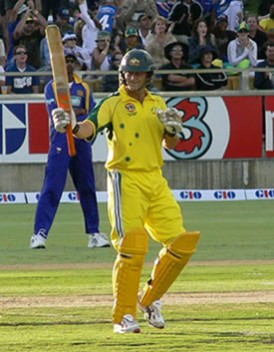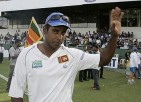Gauntlets For Nothing, Willow For Free… Almost
Richard Dickinson |
Adam Gilchrist. Greatest wicketkeeper-batsman in history. Revolutionary, who changed the role of the wicketkeeper-batsman forever, so that now everyone wants a Gilchrist and wicketkeepers, whose batting was almost irrelevant before he graced the scene, now have to bat well. One of these statements true as truth itself. The other, requiring to be away with the faeries to believe.
Yes, there is precious little doubt that Gilchrist was a better batsman than anyone who ever kept wicket in Test cricket to a good standard for a lengthy period. But precisely because he was so good there is absolutely no chance of any team having anyone remotely as good any time soon – very possibly ever. For the first half of his career, Gilchrist batted as precious few have in Test cricket – his first 42 Tests produced an average of 60.80 – and this was just the half of it. His strike-rate, 83.39, was almost beyond comprehension. No-one has ever scored that many runs, that quickly, over that many Tests. And not only did Gilchrist do this, but he was keeping wicket well at the same time.
To believe anyone is likely to do that again is fanciful. Although Gilchrist was unable – unsurprisingly – to maintain that standard of performance (his last 47 Tests produced an average of “only” 35.70, though most of this came in a short bout of 8 games in 2004/05 – in the other 39 he averaged just 26.94), his place as the greatest wicketkeeper-batsman in Test history is assured for now and it will take a truly phenomenal physical specimen to take it from him.
The reality, too, that is being regularly overlooked at the current time is that it is rare – and always has been – to have even something from the next rung down below Gilchrist. A genuine Test-class batsman who can nonetheless keep wicket to an acceptable standard (and not exhaust himself doing both of these simultaneously) is a massive bonus, and will continue to be. It has been a long time since it ceased to hold true that the best wicketkeeper plays, regardless of his batting ability, and expectations of how well a wicketkeeper must bat have been raised gradually in recent decades. But it will always take a special cricketer to be both Test-class batsman and Test-class wicketkeeper.
There have been a handful of these down the ages: Billy Murdoch was arguably the first, and it so enraged Australia’s first great bowler Fred Spofforth when he beat Jack Blackham (who many still regard as the finest gloveman in history) to a place in the inaugural Test in England in 1880 that he refused to play. Test cricket in Murdoch’s day was sufficiently haphazard that he appeared for both Australia and England within a few years, and the first great batsman-wicketkeeper of the age when Test cricket was as we might recognise it now was England’s Les Ames. Yet it should be stressed that Ames was to most people’s mind the best wicketkeeper in the country at the time of his selection – George Duckworth (incompetent of bat) had been his superior for a time, but between 1929 and 1938/39 Ames rendered wonderful service to his country with gauntlets and willow.
That is not to say that in Ames’ day no other wicketkeeper knew one end of a bat from the other. Sammy Carter and Bert Oldfield, who were Australia’s first-choice between 1907 and 1937, both averaged in the low 20s with the bat and made Test half-centuries. Ames’ successor Godfrey Evans, though he averaged just over 20, made two Test centuries and was considered good enough as an all-round package to keep out Keith Andrew, a man many regard as one of the best glovemen of all-time but who never took his batting seriously. Richard Spooner, who stood-in for Evans on a handful of occasions, could bat too.
South Africa’s Test team has only extremely rarely featured a wicketkeeper whose batting was of no note: captain Percy Sherwell scored a Test century as wicketkeeper as early as 1907; his successor as captain, wicketkeeper and batsman, HB Cameron, averaged over 30 in Test matches; Billy Wade was no mug; John Waite a highly skilled all-round cricketer; and Denis Lindsay, the last man to keep before isolation, one of the best of them all from any country. Arguably, David Richardson, who held the gloves for the first 5 years after their return to international cricket, was the weakest batsman of the lot. Mark Boucher has certainly done himself proud and may yet play for many more years.
Pakistan’s first Test wicketkeeper, Imtiaz Ahmed, could certainly bat as well – he averaged over 30 when wearing the gloves and scored a double-century. After the Second World War, West Indies too realised that a wicketkeeper who did not bat was a handicap. First they gave the gloves to Clyde Walcott, though this reduced his superlative batting to merely good, and the experiment was soon abandoned. Gerry Alexander did a better job, and even though there were complaints about his selection due to the belief that there were better wicketkeepers in the Caribbean, he averaged over 30 with the bat and eventually silenced the doubters.
India took a while to produce a high-class wicketkeeper who could also bat, but as so often, when it finally happened, two came along at the same time – Budhi Kunderan was unfortunate to be a contemporary of Farrokh Engineer, as had they come along one after the other, both would almost certainly have had long careers. After Evans, England mostly picked Jim Parks, a highly capable batsman and, rather like Alec Stewart later, one who eventually manufactured himself via dedication to the job into a very good catcher standing back. Parks’ successor, Alan Knott, was not merely one of the best wicketkeepers of them all but another very fine lower-order batsman.
In spite of all of these examples, there were still plenty of wicketkeepers in the first 70 years of the 20th-century who had notable Test careers regardless of the fact they had no great ability with the bat: England’s AA “Dick” Lilley, Herbert Strudwick and Duckworth himself (though it should be noted that Lilley was many times preferred to Strudwick on account of his useful number-nine-standard batting, compared to the rank number-eleven rabbit Strudwick); Australia’s JJ Kelly, Don Tallon, Gil Langley, Wally Grout and Brian Taber; South Africa’s Tommy Ward; New Zealand’s AE Dick and JT Ward; and India’s Khokhan Sen, Nana Joshi and Narendra Tamhane. And mostly, those picked as stand-ins, who played odd Tests over lengthy spans, tended not to be batsmen of much note. All of this meant that the Test batting average for a designated wicketkeeper between the seasons of 1899 and 1969/70 was 21.87.
The leading Test sides at the dawn of the 1970s, South Africa, England and India, all had high-class wicketkeeper-batsmen: Lindsay, Knott and Engineer (though the South Africans would of course soon be banished). Australia immediately brought in Rodney Marsh, who would prove their best wicketkeeper-batsman to date over the next few years, before averaging under 20 for the second half of his career. West Indies quickly realised the value of lower-order runs and begun to pick Deryck Murray, who averaged in the mid-20s while not reaching quite the standards of the aforementioned. New Zealand finally found a wicketkeeper-batsman of some note in Ken Wadsworth, and after his tragically early death in 1976 his successors Warren Lees and Ian Smith also did a decent job (both, in fact, made scores in excess of 150 in Tests).
After 1970, only two wicketkeepers had lengthy careers without being able to bat to some degree: Bob Taylor, who plenty believed a better wicketkeeper even than Knott, took advantage of Knott’s decision to join the two great rebellions of his time, World Series Cricket and the South African Rebel tours, and played 55 Tests between 1977/78 and 1983/84, even though he was already 36 years old at the start. Still, there were times when he found himself replaced by Paul Downton, though Downton’s batting produced sufficiently little at Test level to render the advantage of this questionable. And Pakistan’s successor to Imtiaz, Wasim Bari, played for over 16 years and sometimes batted as low as eleven.
Everywhere else, however, the times were changing: Syed Kirmani may have been another of the finest glovemen of them all, but he needed to be able to bat to some degree to follow Engineer, and did. As well as Downton, England also tried Bruce French and Jack Richards in the 1980s, mostly on account of their batting (like many England players that decade, those three failed to live-up to the nation’s hopes). Pakistan followed Wasim with Saleem Yousuf, a capable lower-middle-order batsman. West Indies came-up with the trump card: after Deryck Murray’s retirement, they initially tried his namesake David Murray, but on finding his batting not of sufficient quality they turned to Jeffrey Dujon, who for the first two-thirds of his career was almost as good as their usually browbeating top six with the willow – he averaged 37.
Australia went to levels perhaps never before seen – when Marsh hung-up his gloves, they gave the wicketkeeper’s position to opening batsman Wayne Phillips, purely on the hope that he would turn-out to be a wicketkeeper of sufficient quality. This did not prove successful, and Phillips’ batting was affected so badly that his Test career was over by the age of 28. Sri Lanka, who had struggled for any wicketkeeper-batsman of sufficient quality since their elevation to Test status, sometimes gave the gloves to Hashan Tillakaratne. After unsuccessful experiments with Tim Zoehrer and Greg Dyer Australia elected for Ian Healy, who took a long time to turn into a batsman fit to grace their middle-order, but averaged nearly 36 between 1993 and 1998.
By the time the 1990s rolled around, all doubt had been eliminated – to keep wicket in Test cricket, you had to at worst average in the mid-20s. Healy bettered this, but for most countries this was the best they could do: England, with Jack Russell; South Africa, with Richardson; New Zealand, with Adam Parore and Lee Germon; India, with Kiran More and Nayan Mongia; Pakistan, with Moin Khan and Rashid Latif; Sri Lanka, with Romesh Kaluwitharana; and West Indies, with Junior Murray. Being a good wicketkeeper alone was no longer enough, as David Williams, Pubudu Dassanayake, Ajay Ratra, Chris Read and Robbie Hart found-out. In the second half of the decade England were blessed when (after a tough initiation in which he was often asked to keep wicket on a temporary basis, rarely scored many runs as wicketkeeper and fumbled too regularly) Alec Stewart finally turned himself into a top-class Test batsman-wicketkeeper – between 1996/97 and 2002/03, he averaged almost 40 while rarely missing a chance. All of this meant that the Test batting average of a designated wicketkeeper between 1970/71 and 2008/09 (excluding games for and against Bangladesh) was 28.01.
Nonetheless, the likes of Stewart have and will always remain extreme rarities: in Ames, Lindsay, Dujon and of course Gilchrist he is in rare company in being able to bat to Test standard and keep wicket well enough, over a long period of time (Brad Haddin’s early signs suggest he may eventually join this company). The danger now is that expectations may be raised too high, with teams giving the gloves to batsmen whose wicketkeeping is inept in an effort to strengthen their sides and winding-up weakening them, as England have with Matthew Prior; India with Deep Dasgupta and Parthiv Patel; Pakistan with Kamran Akmal; and Zimbabwe with Andy Flower. The risk, too, always remains that a batsman potentially of the very highest class will, with the gloves on, be rendered incapable of doing full justice to his talent, as has generally happened when Kumar Sangakkara has been given the wicketkeeper’s position for Sri Lanka, in spite of his own preference for wearing the gloves and his not-inconsiderable skill when doing so. Many of his current and former team-mates, however, have commented on how much the role has sometimes appeared to exhaust him, especially in the furious heat of places like Colombo. Hence several times over his career Sangakkara has been given the gloves then had them removed.
Even as some wicketkeeper-batsmen raise the bar still higher (Mark Boucher, Brendon McCullum and Mahendra Dhoni have all suggested they can average in the 30s while not allowing their wicketkeeping standards to slip nor finding themselves drained by the non-stop intensity), it remains the case that most (Prasanna Jayawardene, Tatenda Taibu, Denesh Ramdin, James Foster, Geraint Jones, Tim Ambrose, Dinesh Karthik to name a few of recent times) cannot manage this. In the search for balance, selectors must be wary of tipping the scales too far in one direction. A competent wicketkeeper is not something any serious cricket team can afford to make do without.





Yeah, the bar has been raised too high I think. It used to be good enough for a keeper to bat at 7, now it seems he has to be able to bat in the top six. A pity if it means that the best keeper will miss out more often than not. Awesome player that he was, Gilchrist didn’t do his successors and rivals any favors.
Comment by stumpski | 12:00am BST 5 May 2009